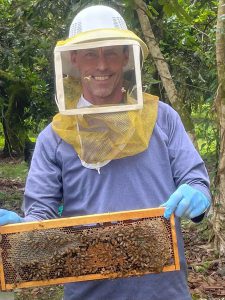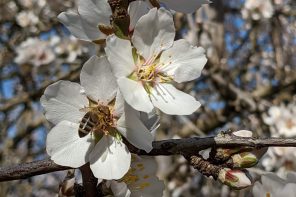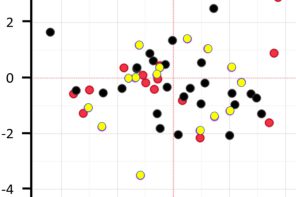Part 2 – What’s in a Queen?
By: James Masucci
“Men are from Venus, women are from Mars.” Or is it the other way around? No matter. The point is, people communicate, and therefore think, differently. I often think differently than others, probably because I’m a science geek. I also appreciate, and take advantage of, the different thoughts of others. If you read my article “A bee-driven mid-life crisis” in the January issue of Bee Culture, you know I’m struggling with a lot of questions. I’m newly retired and transitioning into a full-time beekeeper. Questions like, how big do I want to be? Where am I going to put all my stuff? What stuff do I really need? What’s my business model? And the list goes on. But the backbone of a bee business is, the bees. The backbone of the bees is their genetics. I’ve been thinking a lot about that lately. How do I want to handle bee genetics?
Every queen rearing class I’ve taken, every book I’ve read and every YouTube video I’ve watched always talks about selecting the best hive for the queen mother. To me, that sounds like a great strategy for creating genetic bottle necks. Think inbreeding, not good. No one ever talks about what it takes to maintain genetic diversity. Last year, I requeened my 150 colonies with queen cells from two queen mothers. Having the source of my entire apiary traced back to two queens could be a genetic nightmare. What saves me is the queens were mated over two counties. The diversity comes in from the drones. But here’s the catch, if you are selecting for traits, the males need to be selected too. By putting the same selection pressure on the drones as you do the queen, you are minimizing diversity.
Why do I care? First, a genetically diverse population is better prepared to handle stressors. As an example, look at COVID. Some people died while others were asymptomatic. A very complex situation, but genetics plays a part. So, my mantra is that genetic diversity is good. I have been contemplating applying to the HILO queen project (www.HiloBees.com) to help them develop their mite tolerant trait. But here’s the thing. It’s a multigenic, recessive trait. In order to be effective, 50% of the drones need to have the traits. If I want to get to a point where I can propagate these queens (getting HILO project permission first, of course), then I must be in an isolated area where the only drones available for mating must be heavily selected for the trait. This situation is a step away from incest. This same argument holds true if I want my bees to be true Caucasians, or true Carniolans. Is this a good thing? In my way of thinking, my mutt bees are better, in the long run, than a highly selected bee stock.
In January this year I got the following text from John Miller of Miller Honey Farms. “I read your piece in BC. It’s time to experience almond bloom. I’d love to host you in the Modesto area in late February. Do a day or two there. Then head north to look at a couple of queen operations.” Perfect. What better way to figure out my future and address my questions than to spend a week hob-knobbing with the experts. For my genetic diversity question, I go back to the “Then head north to look at a couple of queen operations.” This is my chance to get opinions from a couple of the top queen producers in the country. Here’s what I wanted to know. First, are today’s queens better than the queens from 40 years ago? The premise of this question is simple, are current bee breeding practices making better bees? As an example, look at corn. Yields are higher and pest resistance is better so one could argue that corn breeding programs are successful. Not so obvious with bees and I wanted to hear what the experts had to say. Next, I wanted to know how they selected for traits and how did they insure genetic diversity. My hope was to get into some geeky conversations regarding drone:queen mother ratios and population genetic models. Here’s what I learned.
First off, these operations are phenomenal. If you are putting out hundreds of thousands of queens per year, you need a system and you need to know what you are doing. It really put me in my place. I was happy with my 150 queen cells last year. Hah! They are doing a thousand a day and running tens of thousands of mating nucs. This is in the heart of queen production in CA, the so-called golden triangle. Bees are everywhere.


Open mating with multiple drones complicates the propagation of a trait as simple as body color. It makes breeding for complex traits nearly impossible. Instrumental insemination can make breeding doable in small scale. But traits are soon lost with
uncontrolled open mating. How often do you see different colored bees in your hives?
I was a little nervous about asking my first question as it could be construed as an “attack” on their livelihood. But the conversation that ensued was fabulous. “Are queens better now than when you first started or, are we just maintaining quality?” First, it’s a difficult question because environmental stressors have changed over time. So, the question resembles the “apples to oranges” comparison. In general, they have been maintaining queen quality. There aren’t huge differences. However, improvements have been made. Chalkbrood and foulbrood are much rarer than they used to be. That is likely due to the continued selection for disease-free lines to use as queen mothers. In addition, they’ve also been selecting for hygienic behavior. Hygienic behavior is a recessive trait, requiring it to come in from both the drones and the queen. So, how do they select for hygienic behavior yet maintain genetic diversity? The key is that there was a “group” decision decades ago to select for hygienic behavior among many, if not most of the queen producers in the region. The result of that decision is that drones from many different genetic sources were selected for the trait. Over time, a large number of genetically diverse drones containing the hygienic traits became available for mating. With mating nucs set up throughout the county, genetic diversity was “maintained” by the drones. So, like my situation where the diversity came in from the drones in different areas, so too in Northern CA, just times a million.
I have not spoken with the breeders of the HILO project, so I don’t know their breeding strategy or their plans for genetic diversity. The one thing I do know is that the tools to properly bring this recessive trait quickly and efficiently into the hands of beekeepers are not available. What’s needed is a good genetic map of the honey bee and marker assisted breeding. We need to get to a point where the trait no longer defines the line. Instead, the trait is introduced into several lines to increase the quality of those lines. These are the tools used in almost every other agricultural industry, including both plants and animals.
In my opinion, the lag in honey bee breeding has two causes. First, bee genetics are hard. Why? The promiscuous mating behavior of the queen makes it impossible to control which drones mate with her. The drones from a region gather in drone congregation areas (DCAs). This is where the queen goes to mate with 10-20 drones. It has been reported that drones can travel seven km (over four miles) to reach a congregation area. Now, take a map and draw a circle with a four mile radius around your apiary. That’s a large area, over 12 square miles. How many colonies other than your own are in that area? Any queen you produce, whether by grafting, supercedure, or on the spot queen rearing will have access to drones from that entire area. Plus, she is mating with multiple drones, each carrying different genetics. This is great for genetic diversity, because it results in several different genetic populations of bees in the colony (have you ever seen different colored bees in a colony?). But, it also means that the likelihood that your queen mated with the appropriate drones is tiny. The inability to control mating in large scale makes true queen breeding extremely difficult. Now, think of the “golden triangle” which is full of queen breeders. Think how difficult it is for them to maintain even the simplest traits because of the diversity of drone population.
For the small-time beekeeper like me, unless truly isolated, breeding for improvement is probably a waste of time. You can, however, maintain good, healthy queen stock. Selecting your best colonies for queen mothers will work because all the queen producers are using similar selection criteria. If you are selecting for chalkbrood-free colonies and those virgin queens go out to mate, it’s likely the drones came from colonies where the queens were also selected from chalkbrood-free colonies. However, if you are trying to select for a complex trait like hygienic behavior, you could have the best queen in the world and you won’t be able to propagate it. The moment those daughter queens reach the DCA, packed with non-hygienic drones, the trait is lost. This is why it was so important for the queen producers to work together to select for hygienic behavior. Having everyone in the region doing the same selection meant that, over time, the complex hygienic trait was carried by a good proportion of drones. Therefore, the odds of a queen mating with at least a few drones carrying the trait are good.
I believe the second reason why honey bee breeding lags behind the rest of agriculture is because the bee industry is relatively small. There is neither the money nor the people-power to develop the tools. There are groups working on it but developing the appropriate lines to evaluate will take a large, concerted effort. I hope the beekeeping community, its benefactors, and its researchers can come together to develop a large, collaborative effort to reach this long-term goal in as short a time as possible.
Click here to go directly to Part 1 – Bee Driven Mid-Life Crisis








